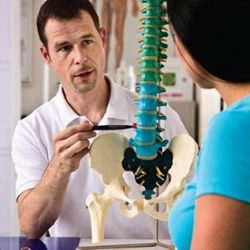Diagnosing Sciatica
Diagnosing sciatica and getting to the root of back pain problems is extremely important so that the right solution can be decided upon. This is especially the case with sciatica.
In order to decide the most effective treatment option for sciatica it is extremely important the right diagnosis is done to understand the underlying medical cause of the sciatic nerve pain. Let’s take a look at the major causes of sciatica:
- Degenerative Disc Disease – A natural process where the discs in the spinal column break down and can lead to the irritation of the nerve root causing sciatica pain
- Lumbar Herniated Disc – When the soft inner core of the disc leaks out to the fibrous outer core which then irritates the nerve roots
- Lumbar Spinal Stenosis – A condition that occurs when the spinal canal is narrowed causing sciatica-related pain
- Isthmic Spondylolisthesis – When one vertebral column slips forward on the other due to a small stress fracture
- Piriformis Syndrome – When the piriformis nerves starts pressing or compressing the nerve root that contains sciatica nerve, it can cause sciatic nerve pain
Factors in Diagnosing Sciatica
 It is important that a proper diagnosis of the cause of the sciatica is done so that the right treatment option can be selected so that the symptoms are relieved in the most effective manner possible. A specialist dealing in spinal disorders will perform a complete physical examination in order to understand the patient’s symptoms better. He will also study the medical history as well as other health issues that the patient is suffering from.
It is important that a proper diagnosis of the cause of the sciatica is done so that the right treatment option can be selected so that the symptoms are relieved in the most effective manner possible. A specialist dealing in spinal disorders will perform a complete physical examination in order to understand the patient’s symptoms better. He will also study the medical history as well as other health issues that the patient is suffering from.
Use of diagnostic tests and examinations are restricted unless the sciatica pain is extremely severe or long lasting. The usual tests that are done for sciatica include:
- Blood Tests
- MRI scan
- CT scan
- X-rays
Treating Sciatica Non-Surgically
- Heat/Ice Packs
- Pain Medications
- Epidural Steroid Injections
- Chiropractic/Manual Manipulation
- Acupuncture
- Massage therapy
Available Surgical Options for Sciatica
In cases where individuals suffer from severe pain that is not relieved within six to twelve weeks of non surgical treatment, it is reasonable to consider surgery. Typical surgical options include:
- A lumbar laminectomy (an open decompression)
- A microdiscectomy (or small open surgery)

